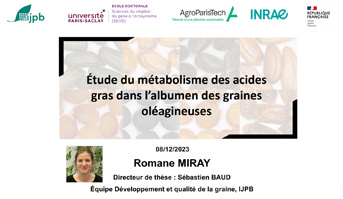Thesis defense: Romane Miray
Friday, December 8th 20, 1:30 pm, INRAE, Versailles
Study of fatty acid metabolism in oilseed endosperm
Brassicaceae seeds accumulate 90 % of their storage lipids in a massive embryo, while the remaining 10 % is stored in the endosperm, comprising a single layer of cells surrounding the embryo. Due to the small size of the endosperm, little attention has been paid to its metabolism. This work focuses on fatty acid metabolism at different stages of endosperm development, from seed maturation to germination.
During seed maturation, the endosperm synthesizes large quantities of fatty acids, which are mainly used to form reserve lipids. Acyl-ACP desaturases (AADs) are soluble desaturases that introduce unsaturation into the aliphatic chain of saturated fatty acids to produce monounsaturated fatty acids. There are several classes of monounsaturated fatty acids: while omega-9s are ubiquitous in plants, omega-7s are mainly synthesized in the endosperm. By separately analyzing the fatty acid content of the endosperm fraction and the embryo in the seeds of 257 Brassicaceae species, we have shown that this trait is perfectly conserved within the family. In addition to Brassicaceae, we found this trait in Asclepiadaceae, but not in any of the other plant families studied. In parallel with this biochemical approach, an exploration of genomic data coupled with the functional characterization of AADs expressed in a heterologous system allowed us to demonstrate that the ability of different plant families to synthesize omega-7s is the result of an evolutionary convergence. Finally, combined biochemical and functional genomic approaches have shown that omega-7s are present in a variety of lipid classes.
Fatty acid desaturases (FADs) are another class of membrane-bound desaturases that produce polyunsaturated fatty acids. A reverse genetic approach in the model species Arabidopsis thaliana has shown that the different isoforms of FADs do not contribute equally to the synthesis of polyunsaturated fatty acids in the embryo and in the endosperm during seed maturation.
Finally, during germination, we compared the metabolism of lipid reserve mobilization in the embryo and in the endosperm. We observed an earlier mobilization in the endosperm and a different regulation of this metabolism between the two tissues. At this stage, it remains to be determined whether some of the peculiarities of fatty acid metabolism in the endosperm confer an evolutionary advantage.
Supervisor: Sébastien Baud- CNRS, INRAE, IJPB, Versailles
Members of the jury:
> Eric Maréchal (Rapporteur) - CNRS, CEA-Grenoble, LPCV, Grenoble
> Sébastien Mongrand (Rapporteur) - CNRS, INRAE, LBM, Villenave d'Ornon
> Sabine D’Andréa (Examinatrice) - AgroParisTech, INRAE, IJPB, Versailles
> Karine Gallardo (Examinatrice) - INRAE, Agroécologie, Dijon
> Victoria Gomez (Examinatrice) - CNRS, Institut de Biologie, Paris
To attend, contact Sébastien Baud
Brassicaceae seeds accumulate 90 % of their storage lipids in a massive embryo, while the remaining 10 % is stored in the endosperm, comprising a single layer of cells surrounding the embryo. Due to the small size of the endosperm, little attention has been paid to its metabolism. This work focuses on fatty acid metabolism at different stages of endosperm development, from seed maturation to germination.
During seed maturation, the endosperm synthesizes large quantities of fatty acids, which are mainly used to form reserve lipids. Acyl-ACP desaturases (AADs) are soluble desaturases that introduce unsaturation into the aliphatic chain of saturated fatty acids to produce monounsaturated fatty acids. There are several classes of monounsaturated fatty acids: while omega-9s are ubiquitous in plants, omega-7s are mainly synthesized in the endosperm. By separately analyzing the fatty acid content of the endosperm fraction and the embryo in the seeds of 257 Brassicaceae species, we have shown that this trait is perfectly conserved within the family. In addition to Brassicaceae, we found this trait in Asclepiadaceae, but not in any of the other plant families studied. In parallel with this biochemical approach, an exploration of genomic data coupled with the functional characterization of AADs expressed in a heterologous system allowed us to demonstrate that the ability of different plant families to synthesize omega-7s is the result of an evolutionary convergence. Finally, combined biochemical and functional genomic approaches have shown that omega-7s are present in a variety of lipid classes.
Fatty acid desaturases (FADs) are another class of membrane-bound desaturases that produce polyunsaturated fatty acids. A reverse genetic approach in the model species Arabidopsis thaliana has shown that the different isoforms of FADs do not contribute equally to the synthesis of polyunsaturated fatty acids in the embryo and in the endosperm during seed maturation.
Finally, during germination, we compared the metabolism of lipid reserve mobilization in the embryo and in the endosperm. We observed an earlier mobilization in the endosperm and a different regulation of this metabolism between the two tissues. At this stage, it remains to be determined whether some of the peculiarities of fatty acid metabolism in the endosperm confer an evolutionary advantage.
Supervisor: Sébastien Baud- CNRS, INRAE, IJPB, Versailles
Members of the jury:
> Eric Maréchal (Rapporteur) - CNRS, CEA-Grenoble, LPCV, Grenoble
> Sébastien Mongrand (Rapporteur) - CNRS, INRAE, LBM, Villenave d'Ornon
> Sabine D’Andréa (Examinatrice) - AgroParisTech, INRAE, IJPB, Versailles
> Karine Gallardo (Examinatrice) - INRAE, Agroécologie, Dijon
> Victoria Gomez (Examinatrice) - CNRS, Institut de Biologie, Paris
To attend, contact Sébastien Baud
Back
